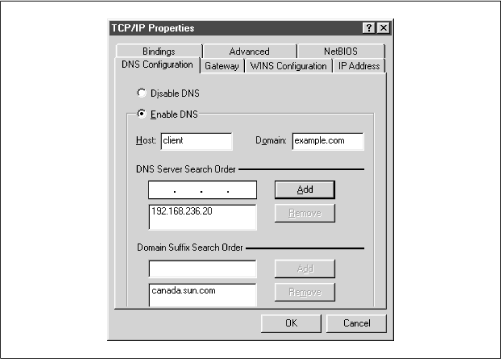Domain Name Service (DNS) is responsible for translating Internet computer names such as
hobbes.example.com into machine-readable IP addresses such as 192.168.236.10. There are two ways to accomplish this on a Windows 98 machine: you can specify a server to do the translation for you or you can keep a local list of name/address pairs to refer to.
Networks that are connected to the Internet typically use a server, since the hosts files required would otherwise be huge. For an unconnected LAN, the list of possible hosts is small and well-known and might be kept on a Unix machine in the
/etc/hosts file. If you are in doubt as to whether a DNS server is being used, or what its address might be, look at the file
/etc/resolv.conf on your Unix servers. Any machine using DNS will have this file, which looks like:
#resolv.conf
domain example.com
nameserver 127.0.0.1
nameserver 192.168.236.20
In the example shown, the second
nameserver line in the list contains the IP address of another machine on the local network: 192.168.236.20. It's a good candidate for a DNS server.[]
You must type the correct IP address of one or more DNS servers (note that you
cannot use its Internet name, such as
dns.oreilly.com) into the appropriate field in
Figure 3.10. Be sure not to use 127.0.0.1 - that will never be the correct DNS server address!
Try to select addresses on your own network. Any name servers listed in
/etc/resolv.conf should work, but you'll get better performance by using a server nearby. (If you don't find
/etc/resolv.conf files on your Unix machines, just disable DNS until you can find the address of at least one DNS server.) Let's assume you only have one DNS server, and its address is 192.168.236.20. Click the Enable DNS radio button, as shown in
Figure 3.10, and add the server's address to the top DNS Server Search Order field.

Also, provide the name of the Windows 95/98 machine and the Internet domain you're in. You can safely ignore the Domain Suffix Search Order field for anything related to Samba.
